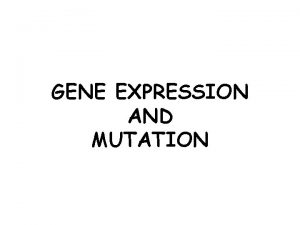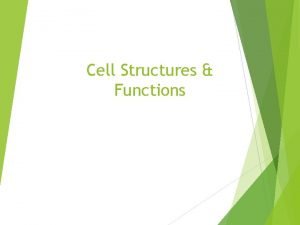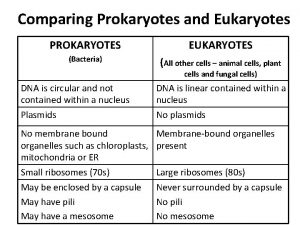COMPARING PROKARYOTES AND EUKARYOTES DISTINCTIONS SIMILARITIES Prokaryotes 1



- Slides: 3

COMPARING PROKARYOTES AND EUKARYOTES DISTINCTIONS SIMILARITIES Prokaryotes 1. All bacteria. 2. Complexity at 106. 3. No nuclear membrane. 4. Single, circular chromosome. 5. Devoid of membrane bound organelles. 6. Reproduce by fission. 7. Flagella for locomotion. Eukaryotes 1. Life is the basic properties of both cells. 2. Cultured and reproduced for extended periods. 3. Highly complex and organized. 4. Similar genetic program and protein synthesis machinery. 5. Acquire and utilize energy: similar reactions and via ATP. 6. Reproducing genetically identical daughter cells. 7. Capable of locomotion. 8. Response to stimuli in environment. 9. Capable of self regulation. 1. Protists, fungi, plants, animals. 2. Complexity at 109. 3. True membrane bound nucleus. 4. Many chromosomes made of DNA and protein. 5. Membrane bound organelle and cytoskeleton proteins. 6. Reproduce by mitosis. 7. Cytoplasmic movement, cilia and flagella for locomotion.

COMPARING PROKARYOTES AND EUKARYOTES SIMILARITIES: 1. Life is the basic properties of both cells. 2. Cultured and reproduced for extended periods. 3. Highly complex and organized. 4. Similar genetic program and protein synthesis machinery. 5. Acquire and utilize energy: similar reactions and via ATP. 6. Reproducing genetically identical daughter cells. 7. Capable of locomotion. 8. Response to stimuli in environment. 9. Capable of self regulation. DISTINCTIONS Prokaryotes Eukaryotes What are they? All bacteria Protists, fungi, plants, animals Genetic Complexity 106 109 Nucleus No nuclear membrane True membrane bound nucleus Chromosome Single, Circular Many, Made of DNA and protein Reproduction Fission Mitosis Flagella Cytoplasmic movement, cilia and flagella Locomotion

A Model of the Origin of Eukaryotes





